After many, many hours of hand-sewing, and a stupid mistake and far too much angst, my 5th proper Historical Sew Fortnightly Challenge: Peasants & Pioneers, is done.
I was inspired to make an 18th century brown linen (brown indicating unbleached, rather than dyed brown) shift when I scored a 1.3m length of enzyme washed linen in the $5 end-of-roll bin at Fabric Warehouse. At first I was disappointed that it wasn’t white, and then a helpful blog follower reminded me that brown linen was used to make lower-class shifts throughout the 18th century.
I did a bunch more research on brown linen (which I will be sharing with you on Thursday), and made up my shift:
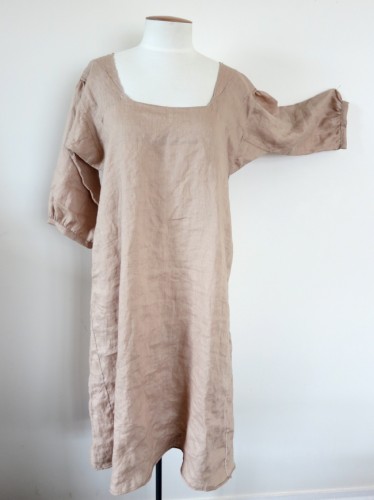
Late 18th century ‘brown’ linen shift
I didn’t have enough fabric to make up a mid-18th century style shift, so I went for late 18th century, when shifts became narrower.

Late 18th century brown linen shift – back
While they are still slightly puffed, late 18th century sleeves also become narrower, with widths the same as their length.

The sleeves with underarm gussets and slightly gathered cuffs
Since I had such lovely fabric to work with, I decided to go the whole 10 yards and hand-sew the shift with linen thread. Shifts are actually easier by hand – it’s so much easier to set gussets by hand than machine.
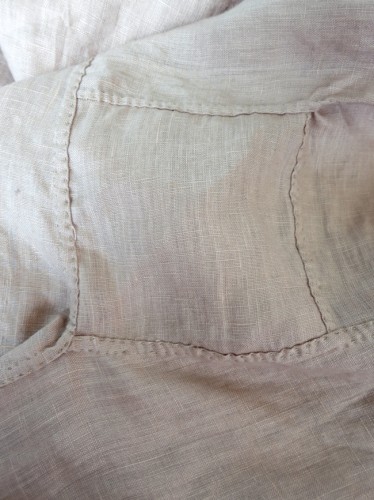
Hand-sewn underarm gussets
I’m quite pleased with my hand stitching – it’s so fun to do on linen, you can just finger press everything, and the thread almost becomes one with the weave of the fabric.
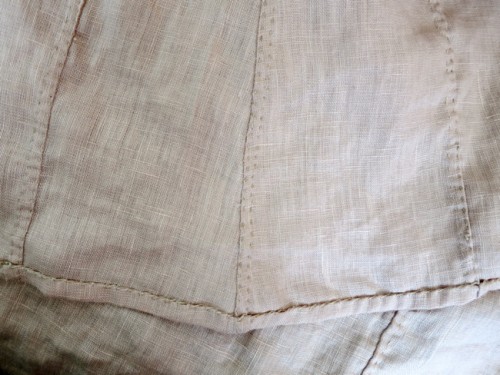
Flat-felled seams and whip-stitched hems
Unfortunately, for all my beautiful hand-sewing, I screwed up the last step and cut the neckline way, way, way too big. You probably noticed it in the first two pictures. So I had to patch it so it was at least remotely wearable.
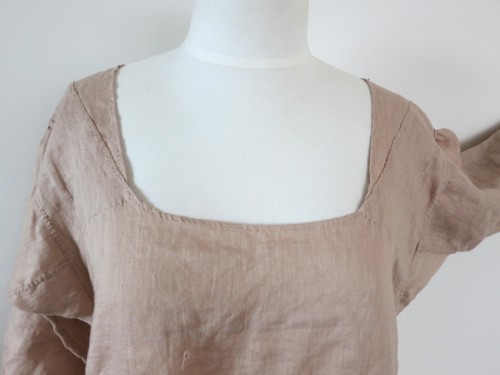
Patches to narrow the neckline
The patches are just hemmed rectangles of fabric that bring the shoulders in. I may add another rectangle to the back neckline to bring it up higher as it is so low.
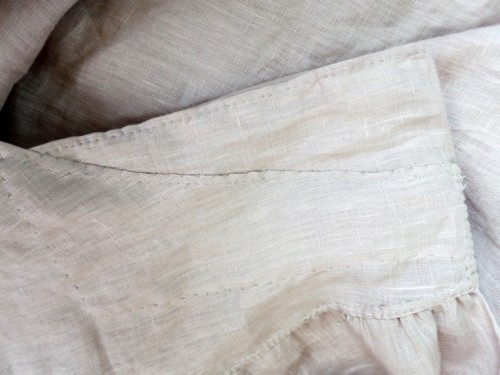
The rectangular patches
I’m gutted that I made such a stupid mistake and ruined what would have been a perfectly historically accurate garment. However I rather like the patches as a decorative feature in a modern way. It gives a rather elegant ‘falling off the shoulders’ without falling off the shoulders look. I may have to play with that idea for a modern shift dress.
And, thanks to the vast quantities of documented patched garments in the 18th c, they probably aren’t that far off historically accurate either!
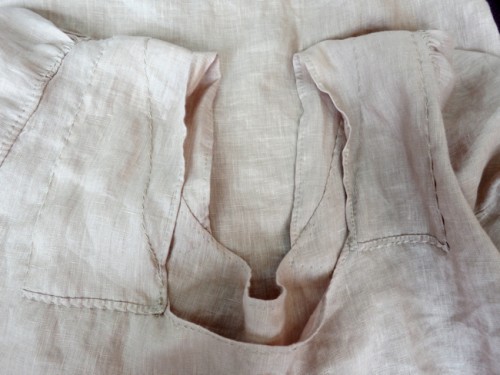
The patches from the inside
I’ve actually sewed the shift with all the flat felled seams facing out, so that the underside is smoother to wear against the skin. And then the patches ruined that too.
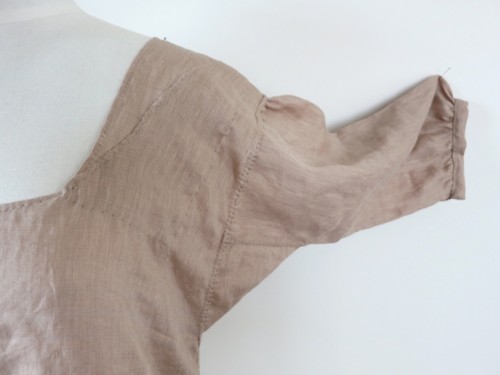
Stupid but elegant patching
Other than the back neckline, I still need buttons to fasten the cuffs of the shifts, so I guess it isn’t 100% done.
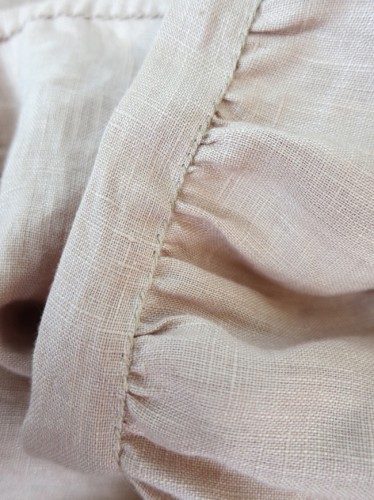
Whipstitched cuffs which still need buttons
The Challenge: Peasants & Pioneers
Fabric: 1.3m unbleached enzyme-washed linen –
Pattern: none, based on historical examples
Year: late 18th-early 19th century.
Notions: linen thread, 2 self-fabric buttons to be added later.
How historically accurate is it? Sigh. Hand sewn, accurate fabric (even Wm Booth doesn’t sell real unbleached linen), accurate stitches and pattern…and then I stuffed up the neckline. 80%?
Hours to complete: 11 – hand sewing takes time, but at least I can multi-task while doing it.
First worn: Not yet.
Total cost: $5 (thank you Fabric Warehouse!)

Hand sewn, flat felled skirt gores


Given that you are baising this off lower class fashion I’m sure that someone at some point did something similar to make a hand-me-down garmet fit. Beautiful work otherwise and I’m in awe of your hand sewing, so very neat and even.
I kind of figured the same thing, but would still have preferred a shift that was ‘perfect’!
Thank you so much for the compliments on my hand stitching! I keep working on it, and am so pleased that it’s getting to be so precise and lovely. 🙂
I like handsewing on linen too, for the same reasons.
Don’t be distressed that you had to patch the neckline to make it wearable! Look at it this way; if you were a lower class woman in the 18th century, you might have made a similar mistake, and it would have been even more important for you to do whatever you could to make the shift wearable, because fabric and clothing were proportionately more expensive than they are for us. I feel I have learned so much about how medieval garments were made by handsewing my own. I don’t mean that I’ve learned about how such garments were cut and pieces, though I have learned such things. But I also feel I’ve learned a lot about the types of economies that were practiced and the sorts of techniques that might have been adopted to speed up the sewing process.
+1 for what Catherine said.
Thanks Catherine. That’s definitely the thought process I went through, but I did curse all the extra work of hemming those rectangles and pinning and sewing them in. 😛
Hey, if you are a peasant, maybe you are just not that great of a sewer. Or it could be a hand me down that needed a bit of work to fit. I think it looks lovely.
Thanks Stephanie!
Or perhaps my first neckline got worn and dirty, I cut it down and patched it? There are all sort of plausibilities.
I’m sure there is many a story through out history of peasant sewers making mistakes and they wouldn’t have used good material to recut peices-even if they had it! They would have rigged up that kind of patch job. If you could make a mistake so could they. They just didn’t have their work make it to a museum so that we could look at it and say “Oh, look someone made a mistake!” (If it did survive, we’d be more likely to say, “Oh look, a peasant with a flare for design!”)
I’m sure you are right! Thank you for your support!
I like the way the shoulders look as well. I also don’t think it detracts from the piece’s historical accuracy. Piecing garments was very common, and if the seamstress made a mistake cutting the garment or had to re-fit a garment originally made for someone else she would have to piece it in such a way.
This happens to me quite often too; I always think my shoulders are wider than they really are (wishful thinking) and end up with a fitting problem.
Thanks Stella.
I actually really like this shift just as a modern garment. I wonder if anyone would notice the hand-stitching if I wore it out and about?
I do hope to never make this mistake with a shift again. The fix was a pain and a half!
Thanks for an up close pic of the undearm gusset. I’m actually having a difficult go at putting in a gusset. The fabric got a little tweaked, bunched and I’m not sure if that’s because of how I sewed the first line of the gusset into place or that I used a 1/2 in seam allowance or what. Any suggestions? Thanks!
Brown linen shifts were not just worn by the lower sort. In wealthier women’s inventories there are brown linen shifts listed. Recently I found a portrait of a Alexander Pope, wealthy poet, in London. He is wearing his banyan over a shirt made of brown linen. I understand this is a portrait of a man not a woman but 18th century pictures of wealthy women in their underwear are few and far between. Because of this I feel brown linen shifts were much more widespread than most modern people believe. http://images.npg.org.uk/800_800/8/5/mw05085.jpg